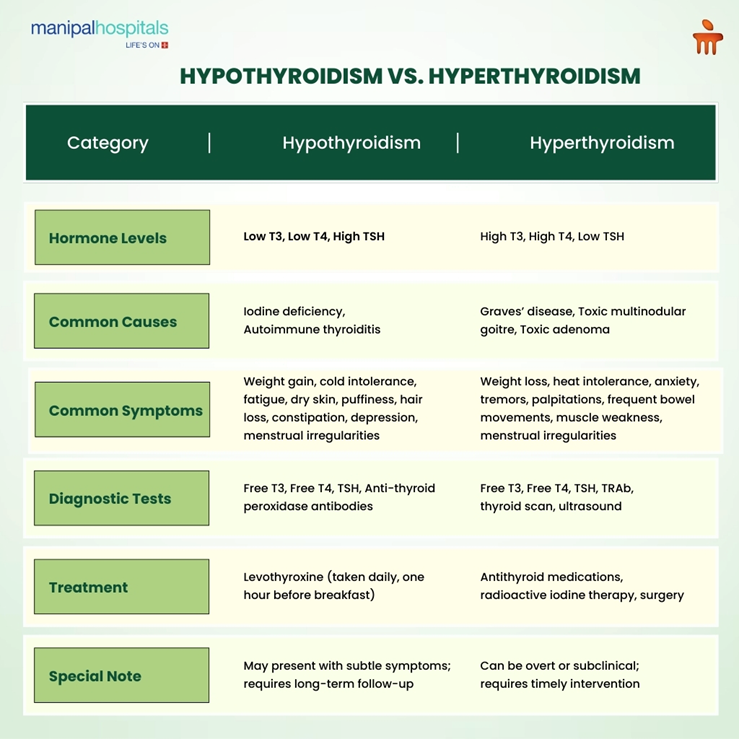
Thyroid disorders are among the most common endocrine conditions in clinical practice, affecting millions of people worldwide. The two primary forms – hypothyroidism and hyperthyroidism – impact metabolism and energy in opposite ways. Treatment needs a timely diagnosis and patient-specific medical care for these conditions, which exist together. Learning about symptoms and therapies for these conditions significantly improves patients' quality of life. An expert physician in Vathur Road, Bangalore, provides information on differentiating hypothyroidism from hyperthyroidism for better management of thyroid health.
Synopsis
What are Hyper and Hypo Thyroidism?
Thyroid disorders develop when the thyroid gland produces excessive (hyperthyroidism) or insufficient (hypothyroidism) amounts of thyroid hormones. Excessive thyroid hormones result in hyperthyroidism, whereas hypothyroidism is a result of thyroid hormone deficiency.
These conditions have distinct features, which we can list below:

-
Hypothyroidism Definition: Insufficient thyroid hormone production from the thyroid gland causes hypothyroidism, which slows down metabolism and leads to weight gain with fatigue.
-
Hyperthyroidism Definition: Excess hormone output within the thyroid gland leads to hyperthyroidism, accelerating all body functions. Graves' disease, toxic nodules, and thyroid inflammation cause hyperthyroidism, which brings substantial physical and emotional changes.
-
Primary vs. Secondary Hypothyroidism: A person with primary hypothyroidism suffers thyroid gland failure, whereas secondary hypothyroidism develops from a dysfunction of the pituitary gland or hypothalamus. Autoimmune thyroiditis, with iodine deficiency, is the main cause of primary hypothyroidism, the most frequent thyroid condition.
-
Overt vs Subclinical Hyperthyroidism: Overt hyperthyroidism presents apparent symptoms and abnormal lab results, whereas subclinical hyperthyroidism may go unnoticed with only low TSH levels and normal T3/T4.
-
Thyroid Hormone Role: Thyroid hormones (T3 and T4) control metabolic rate, body temperature, heart rate, and brain development. Hormonal imbalances can affect nearly every bodily system and should be addressed with personalised treatment strategies.
Symptoms of Hypothyroidism vs Hyperthyroidism
Symptoms of thyroid disorders can vary widely depending on whether the gland is underactive or overactive. Here’s a comparison of key symptoms:
|
Symptoms |
Hypothyroidism |
Hyperthyroidism |
|
Weight Changes |
Weight gain due to slowed metabolism |
Sudden or drastic weight loss despite unchanged or increased appetite |
|
Energy Levels |
Fatigue and sluggishness |
Restlessness, irritability, and inability to sleep due to overstimulation |
|
Temperature Sensitivity |
Cold intolerance |
May feel overly warm and uncomfortable even in mild climates |
|
Hair and Skin Changes |
Dry skin and hair thinning |
Hair loss, warm, moist skin and increased sweating |
|
Heart and Muscle Effects |
Bradycardia and muscle cramps |
Palpitations, tremors, and muscle weakness, especially in the arms and thighs |
|
Menstrual Cycles |
Heavy, irregular periods, or absent periods |
lighter or absent periods |
-
Weight Changes: Weight gain is typical in hypothyroidism due to slowed metabolism, while hyperthyroidism often causes sudden weight loss despite unchanged or increased appetite.
-
Energy Levels: Fatigue and sluggishness are typical of hypothyroidism, whereas hyperthyroidism can cause restlessness, irritability, and inability to sleep due to overstimulation.
-
Temperature Sensitivity: Individuals with hypothyroidism experience cold intolerance, while those with hyperthyroidism may feel overly warm and uncomfortable even in mild climates.
-
Hair and Skin Changes: Hypothyroidism is characterised by dry skin and hair thinning. Hyperthyroidism also causes hair loss, which is accompanied by warm, moist skin and increased sweating.
-
Heart and Muscle Effects: Hypothyroidism may cause bradycardia and muscle cramps, while hyperthyroidism leads to palpitations, tremors, and muscle weakness, especially in the arms and thighs.
-
Menstrual and Mood Disturbances: Both conditions can affect menstruation – heavy or irregular periods in hypothyroidism and lighter or absent periods in hyperthyroidism. Mood swings and cognitive issues are common in both types.
Diagnostic Investigations for Thyroid Disorders
Proper diagnosis of thyroid disorders is essential for determining the appropriate course of treatment. Blood tests and imaging help differentiate between hypo and hyperthyroidism and detect underlying causes.
Here are the standard diagnostic methods:
-
TSH, Free T3, and Free T4 Levels: These are the most essential thyroid function tests. High TSH and low T3/T4 confirm hypothyroidism; low TSH with elevated T3/T4 confirms hyperthyroidism. These tests are the first step in diagnosing thyroid imbalance.
-
Anti-Thyroid Antibodies: The presence of thyroid peroxidase antibodies (TPOAb) helps diagnose autoimmune thyroid disorders, such as Hashimoto’s thyroiditis in hypothyroidism and Graves’ disease in hyperthyroidism.
-
Thyrotropin Receptor Antibodies (TRAb): TRAb levels are particularly useful in confirming Graves’ disease, a common cause of hyperthyroidism, and can help monitor disease activity over time.
-
Thyroid Ultrasound: This imaging test checks for structural abnormalities like nodules, cysts, or goitre. It’s helpful in both hypothyroid and hyperthyroid cases to assess gland health and rule out malignancy.
-
Radioiodine Uptake Scan: Primarily used in hyperthyroidism, this scan measures how much iodine the thyroid absorbs, helping to identify causes like Graves’ disease or toxic nodules.
-
Euthyroid Sick Syndrome Consideration: In hospitalised or critically ill patients, abnormal TSH levels may not reflect actual thyroid disease. Clinicians must evaluate thyroid results cautiously in such cases.
Treatment Options for Hypothyroidism and Hyperthyroidism
Thyroid treatment depends on whether hormone levels are high or low. With medical guidance, most people can manage their condition and live normally.
Here’s how each disorder is typically treated:
-
Levothyroxine for Hypothyroidism: This synthetic hormone replaces deficient thyroid hormones. It must be taken on an empty stomach daily. Regular monitoring ensures the dose remains effective without causing overtreatment.
-
Anti-thyroid Medications: Drugs like methimazole are used in hyperthyroidism to suppress hormone production. They are effective in early stages or for patients awaiting surgery or radioactive iodine treatment.
-
Radioactive Iodine T standard: A common long-term treatment for hyperthyroidism, this therapy destroys overactive thyroid tissue. It may lead to hypothyroidism later, requiring lifelong hormone replacement.
-
Thyroid Surgery: In cases of large goitres, nodules, or failure of other treatments, subtotal or total thyroidectomy may be necessary. It’s effective but requires careful post-operative hormone management.
Conclusion
Understanding the difference between hypothyroidism and hyperthyroidism empowers patients to seek timely care and make informed health decisions. Thyroid disorders can be effectively managed with early diagnosis, proper medical intervention, and routine follow-ups. Consult your physician if you suspect any symptoms of thyroid imbalance and prioritise regular check-ups.
FAQ's
Hypothyroidism usually requires lifelong treatment, while some cases of hyperthyroidism can be cured with radioactive iodine or surgery.
The combination of TSH, Free T3, and Free T4 provides the most accurate insight into thyroid function.
Yes, women are significantly more prone to thyroid disorders, especially autoimmune thyroid diseases.
Yes, women are significantly more prone to thyroid disorders, especially autoimmune thyroid diseases.
Yes, untreated thyroid conditions can affect fertility, pregnancy outcomes, and foetal development.
Once diagnosed, thyroid levels should be checked every 3 to 6 months, as the doctor advises.





















 7 Min Read
7 Min Read












